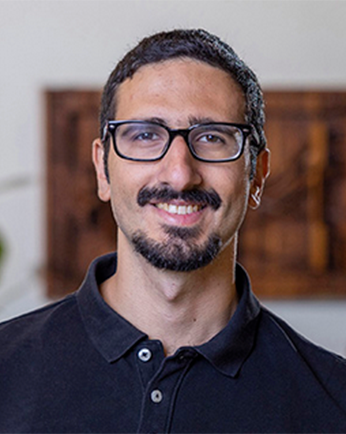Poster Presentations:

PhD Student
Texas A&M University
Presentation Title: A Novel Digital Twin Framework for Efficient Electric Power Restoration and Resilient Recovery in the Aftermath of Hurricanes Considering Interdependencies with Road Networks and Essential Facilities
Co-Author: Maria, Koliou
Abstract: The community's resilience in the face of natural disasters relies heavily on the rapid and efficient restoration of electric power, which plays a critical role in emergency response, economic recovery, and the functionality of essential lifeline and social infrastructure systems. The recent data revolution and advancements in Artificial intelligence (AI) and the Internet of Things (IoT) have paved the way for innovative disaster management and recovery solutions. Leveraging these advancements, the digital twin (DT) concept emerges as a promising tool to enhance the effectiveness of post-disaster recovery efforts. This paper introduces a novel framework for post-hurricane electric power restoration using a hybrid DT approach that combines physics-based and data-driven models by utilizing a dynamic Bayesian network. By capturing the complexities of power system dynamics and incorporating the road network's influence, the framework offers a comprehensive methodology to guide real-time power restoration efforts in post-disaster scenarios. A discrete event simulation is conducted to demonstrate the proposed framework's efficacy. The study showcases how the electric power restoration DT can be monitored and updated in real-time, reflecting changing conditions and facilitating adaptive decision-making. Furthermore, it demonstrates the framework's flexibility to allow decision-makers to prioritize essential and business facilities and compare different restoration plans and their potential effect on the community. The proposed framework has the potential to revolutionize disaster recovery strategies, ultimately contributing to faster recovery, improved emergency response, and enhanced community resilience.
PhD Student
University at Buffalo
Presentation Title: Infrastructure Failure Impacts on Socially Vulnerable Communities in Puerto Rico after Hurricane Fiona
Co-Author: Diana Ramirez-Rios
Abstract: In recent years, the quantity and magnitude of devastation of natural disasters has increased rapidly. Oftentimes, these disasters strike the same location in the span of a few years. It is evident that the initial impact of disasters causes devastation to the affected region. However, the effect of the cascading failures of critical infrastructure (i.e., transportation and electrical grid) on recovery is not as evident. This NSF RAPID research in Puerto Rico helped to better understand the roles of critical infrastructure interdependencies and the effect of cascading failures on critical infrastructure in the community. This included the analysis the restoration interdependencies of the critical infrastructures and its impact on the recovery of socially vulnerable Puerto Rican communities. Fieldwork data was collected in the aftermath of hurricane Fiona to help better understand the interdependencies of the failed infrastructure with restoration efforts and the impacts on the community. Of great importance was the community’s perceived impacts of the response in contrast with the official response, which was gathered through focus group discussions and surveys at six different locations of Puerto Rico. This research analyzes the unique challenges that communities faced and if the impacts of failed infrastructure are more predominant in the highly socially vulnerable communities. We analyzed publicly available data sources and the focus group findings to address these research questions on social vulnerability. All data analysis results, and additional data collected as part of this research will be publicly available through the DesignSafe platform.

Graduate Student
University of Maine
Presentation Title: Exploring Landslide Dynamics using Anura3D: A Study on Numerical Analysis, Rigid Surface Modeling, and Material Point Method
Co-Author: Luis Zambrano
Abstract: Landslides have the capacity to give rise to a multitude of predicaments and outcomes, exerting an impact on both human settlements and the natural ecosystem. A myriad of substantial challenges emerge as a result of a landslide event. These encompass the loss of human life and the occurrence of injuries, damage to property, the unsettling of communities leading to homelessness, and the disruption of crucial infrastructural systems. The comprehension of the behavior inherent to this phenomenon stands as a pivotal factor in alleviating the ramifications it begets. Consequently, the application of numerical methods becomes imperative in facilitating a comprehensive exploration and analysis. Although the conventional finite element method is extensively utilized, its scope is circumscribed when it comes to accurately capturing prolonged deformations and the intricate post-failure dynamics. Moreover, it frequently hinges on intensive and costly contact algorithms. Certain complications linked to landslides can be distilled by considering the interaction between the soil and a rigid body. Instances of such scenarios encompass the engagement between tree roots or ground anchors and the earth. Henceforth, in collaboration with Anura3D, an innovative non-conforming rigid surface has been devised. This innovative approach enables us to unravel the intricacies of landslide behavior and foresee potential failure surfaces. By employing this advanced technique, a more nuanced understanding of the mechanisms driving landslides is attainable, thereby enhancing our ability to predict and manage their repercussions effectively.

PhD Student
University of Florida
Presentation Title: BRAILS-enabled machine learning approach to predict building damage from coastal hazards
Co-Authors: Arthriya Subgranon; Maitane Olabarrieta; John C. Warner; Joseph B. Zambon; Christopher R. Sherwood; Mark Carson; Yanda Ou; Ruoying He; Jennifer Warrillow; Z. George Xue; Eli Hunter; James D. Doyle; Jonathan R. Moskaitis
Abstract: A data-driven machine learning model that predicts hurricane damage at the building level was incorporated into a model that forecasts coastal storm hazards. The building-damage prediction model combines coastal hazard data with building features, land cover, geospatial data, socioeconomic data, and wind and surge fragility data as input features. These features are run through a random forest classifier trained on similar data from reconnaissance of past hurricanes. The probabilities of achieving discrete damage states are predicted for each building in a given inventory. A unique feature of this framework is the ability to generate such a building inventory for virtually any location through use of the BRAILS (Building Recognition using AI at Large-Scale) tool from NHERI SimCenter. In the past, despite robust atmospheric and coastal modeling, building damage predictions were limited to aggregated inventories in the absence of datasets of individual building attributes. In this work, when coastal modelers predict an anticipated landfall region for a hurricane, building footprints are identified throughout that region. The list of building footprints is input into BRAILS Inventory Generator, which collects imagery and creates a database of pertinent features for each building using computer vision methods. The remaining input features for the damage prediction model are measured or calculated for each building. Compiling such databases for coastal regions allows the forecast of building damage concurrent to hazard forecasting. This presentation will examine hindcast damage from past events and discuss the suitability of this approach for real-time forecasts of structural damage as storms approach.

PhD Student
Oregon State University
Presentation Title: Human-centered connectivity and transportation network recovery following a Cascadia Subduction Zone Earthquake and Tsunami
Co-Author: Dan Cox; Dylan Sanderson; Jenna Tilt
Abstract: An integrated approach combining social science and engineering is proposed to evaluate the interconnectivity of coastal communities considering the risks posed by ground shaking and tsunami inundation from the Cascadia Subduction Zone (CSZ). The study measures the resilience of Oregon's coastal communities by converting infrastructure connectivity into quantifiable metrics that consider 1) post-disaster transportation network performance 2) access to critical facilities, utilities, and services and 3) access to community-defined assets such as homes and places of employment. The research approach integrates publicly accessible built environment data with local participatory mapping data to create an inventory sorted by function, capacity, and frequency of use. The extent and magnitude of a full-margin rupture of the CSZ are characterized by the Oregon Department of Geology and Mineral Industries, whereas HAZUS fragility curves are used to simulate damage to transportation infrastructure. These are coupled through a probabilistic regional and local network model to assess transportation network recovery informed by the Oregon Resilience Plan. Results show that at the regional scale, differences in connectivity are dependent on the considerations of various critical facilities and community identified assets. Locally, infrastructure networks are more robust but remain susceptible to major connectivity loss that may reduce the service areas and times associated with emergency critical care. Individual scale assets indicate specific infrastructure vulnerabilities which can be used to inform disaster policies and planning that may reduce community islanding.

Associate Professor
Texas Tech University
Presentation Title: Utilizing Deep Learning to Advocate for Equitable Community Resilience
Abstract: This research investigates the importance of equity considerations in community resilience planning, particularly in the context of the Winter Storm Uri that struck Texas in 2021. Employing multifaceted innovative methodologies enabled by deep learning algorithms and geospatial analysis, the study adopts a comprehensive approach by analyzing power outage data at the census tract level through computer vision techniques applied to nighttime satellite images, as well as conducting household-level surveys. By examining the disproportionate effects of the disaster on vulnerable communities, the study emphasizes the need for equitable recovery strategies to prevent unequal outcomes. The findings underscore the association between specific variables, such as a high percentage of linguistically isolated population together with public transport users, with census tracts that experienced power outages. Moreover, community surveys revealed that multifamily, non-white, and female residents were disproportionately affected compared to single-family, white male residents. To address these disparities, the study advocates for engineering solutions, including grid modernization technologies, microgrid implementation and the incorporation of renewable energy resources. These recommendations highlight the potential for improving equitable power grid resiliency while accounting for region-specific characteristics and the challenges posed by natural hazards.

PhD Student
University of Maryland, College Park
Presentation Title: Effectively Prioritizing Hazard Mitigation Projects for the State of Illinois Through Quantifying Benefits
Co-Author:
Abstract: Prior to 2023, the prioritization of hazard mitigation projects conducted by the Illinois Emergency Management Agency (IEMA) loosely followed guidelines published in the 2018 Illinois Hazard Mitigation Plan by procedurally reviewing and advancing applications on a first come, first serve basis. However, the method of prioritizing projects following the new 2023 Illinois Hazard Mitigation Plan compares competing hazard mitigation projects quantitively through a tailored cost-benefit analysis calculation that feeds into an optimization formulation to maximize benefits while maintaining financial source constraints. However, how to measure benefits quantitatively needed to be determined through the incorporation of key stakeholder input while maintaining ease of use for the decision makers at IEMA. Additionally, the benefits considered for analysis were expanded upon and newly ranked by level of importance based on qualitative feedback received during community stakeholder engagement meetings and based on scientific literature. The developed methodology for the prioritization of hazard mitigation projects is coded into a working tool for use at IEMA to more effectively prioritize mitigation projects in a straightforward manner. This presentation will discuss the process of developing the novel prioritization methodology and also the methodology itself.

Professor
Western Michigan University
Presentation Title: Developing mem-models for natural hazard engineering research
Co-Author: Jin-Song Pei
Abstract: Reliable and computationally efficient models that realistically replicate structural responses under extreme loads are the corner stone in natural hazard engineering research. Flexible implementation of these models in various application scenarios, such as structural response prediction and performance assessment, dynamic response control, hybrid simulation and more, poses further challenges in the model development. A family of mem-models, where “mem” stands for memory, i.e., hysteresis), is emerging as a new and powerful means to capture complex nonlinear behaviors of materials and systems under various types of dynamic loads involving different frequency, amplitude, and loading histories, all based on nonlinear state-space formulation. Mem-models, including mem-dasphots, mem-springs, and more, are transferred from electrical engineering to engineering mechanics using mechanical-electrical system analogies to directly facilitate constitutive modeling, nonlinear system identification, control, and reduced-order modeling. Our work is built on a series of recently published theoretical studies and several real-world case studies of smart devices, which indicate that mem-models offer new physical insights while providing improved computational efficiency. In this study, existing experimental data of a wood structure available at the DesingSafe Data Deport is utilized to understand the usefulness of this new family of models for the natural hazard engineering research community. This proposed presentation will introduce the motivation of this study, review a short summary of published work on mem-models, outline our ongoing research of using mem-models to analyze the selected DesingSafe data, and share our vision for future work leading to a larger impact to the SimCenter user community.

Professor
Louisiana State University
Presentation Title: Large eddy simulation of wind turbulences over non-breaking and breaking waves
Co-Author: Tianqi Ma, Louisiana State University, Ph.D. Student
Abstract: Wind-wave interaction affects wave profiles and wind structures, which essentially influences the combined wind-wave loading on structures. The present study aims to characterize the turbulent airflow over non-breaking and breaking waves. A large eddy simulation based high-fidelity two-phase model is developed to simulate highly turbulent wind-wave fields using OpenFOAM. To capture the complex water-air interface configurations, the volume of fluid (VOF) method is adopted. Turbulent wind is prescribed at the inlet boundary using the turbulent spot method. The developed model is validated by experimental data. With the validated model, a numerical case study is conducted to study wind turbulence evolution in the cases of non-breaking and breaking waves. Research results show that non-breaking waves induce wind turbulences and vary the mean wind velocity. Higher wind forcing produces more wind turbulences. When wave steepness exceeds 0.35, extreme wind forcing strengthens the turbulence by over 100% at the crest height. The strengthened turbulence region extends to approximately a height of 0.6λ. Young waves exhibit higher kinematic energy of wave coherent velocity, particularly in the region below 0.2λ. When waves plunge, the overturning jet propels the wind forward, generating a counterclockwise vortex and enhanced wind turbulences. The mean wind speed is enhanced by over 20% above the wave crest, with the enhanced region extending to a height of approximately 0.2λ in the case of old waves. The intensified wind turbulence remains localized near the wave surface. Additionally, the maximum kinematic energy of wave coherent velocity transiently increases and subsequently decreases during plunging waves.